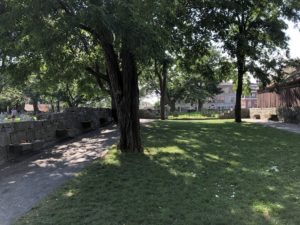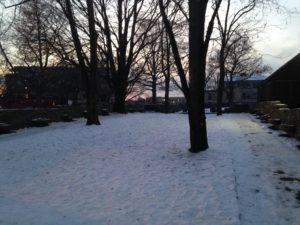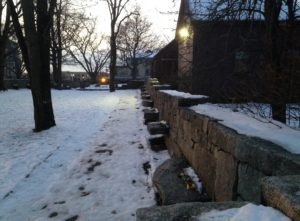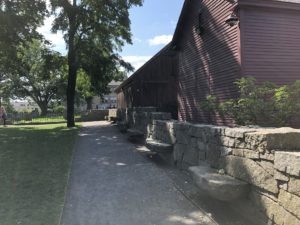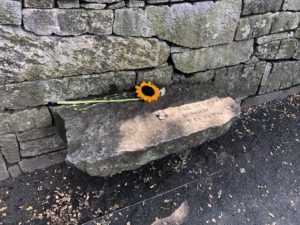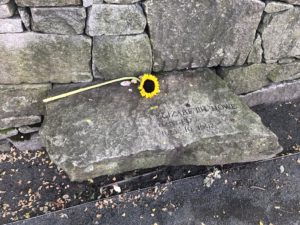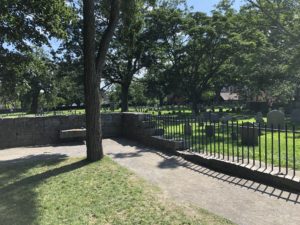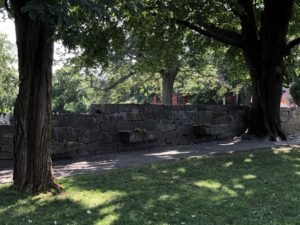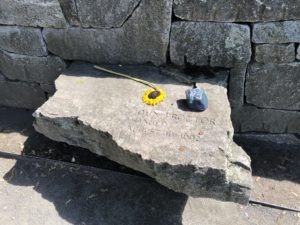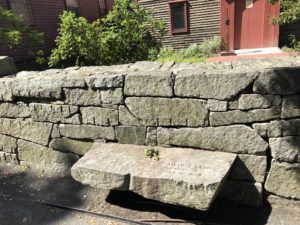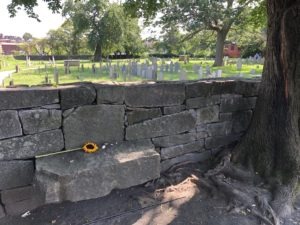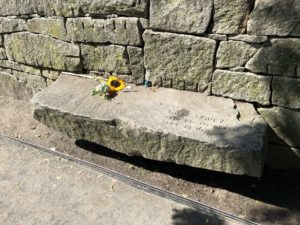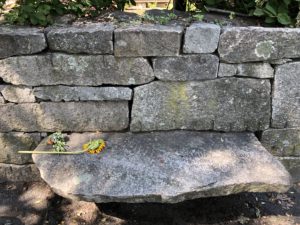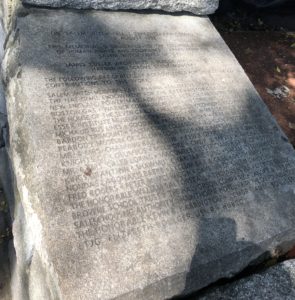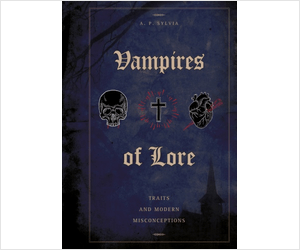Dedicated on August 5, 1992, the Salem Witch Trials Memorial in Salem, MA, serves as a solemn reminder of a dark piece of colonial history. Its most prominent feature is a low stone wall with 20 granite benches projecting from it. Each bench is inscribed with the name of a person whose life was taken due to the witchcraft hysteria that gripped the community in 1692. The memorial’s dignified and unassuming design allows for quiet reflection. With this in mind, let’s explore the infamous events that motivated the building of this public monument 300 years later.
When discussing the witch trials, a potential contributing factor often brought up is the extreme psychological stress present within the community. For example, people were concerned about resources, as the region had an influx of refugees due to a war with France. The populace also feared attack from Native American tribes. Additionally, there had been a recent smallpox epidemic. Even the community itself was divided, with animosity between the rural, agricultural Salem Village (now Danvers) and the wealthy seaport of Salem Town (modern day Salem). Certain supernatural beliefs also added to the stress, as the colonists had a constant dread of evil forces. It was within this atmosphere that the witchcraft hysteria was born.
The hysteria had its genesis in January of 1692, in the home of Salem’s divisive and unpopular minister, Rev. Samuel Parris. It happened that a strange malady befell the minster’s nine-year-old daughter, Elizabeth, and his eleven-year-old niece, Abigail Williams. The girls began experiencing episodes that involved screaming, making strange noises, throwing things, and contortions. The local physician, William Griggs, was unable to find any physical explanation for what was going on. Thus, his diagnosis was witchcraft. The problem didn’t stop with the Putnim household, however. More girls in the village started coming down with the same affliction.
The girls were asked to identify who had bewitched them. They named three women, all of whom were in vulnerable positions in society: Sarah Good, Sarah Osborne, and Tituba. Good was homeless, lived off of charity, and was known for being ill tempered. Osborne was bedridden and had a damaged reputation because her second husband was her former servant. Tituba was an enslaved Native American woman in the Parris household. When brought before the magistrates, all three initially claimed innocence. However, eventually Tituba confessed to being a witch – perhaps due to violent coercion. She then provided extensive testimony relating to her supernatural encounters – such as visits from the devil (a tall man with white hair), threats if she didn’t do his bidding, and the signing of his book. These accounts shocked the community and the hysteria continued.
After these initial hearings, the three accused women were put in jail. Then more accusations started being made, and some were against people of high social standing. Certain members of the community may have also used the witch hysteria to accuse social rivals or those they had a grudge against.
On May 27, 1692, Governor Sir William Phips established the Court of Oyer and Terminer (To Hear and To Decide) to conduct the witch trials. A deadly flaw in the process of the court was that it allowed something known as “spectral evidence.” This is testimony in which a witness claims that the spectre of the accused appeared to them in a dream or vision and caused them harm. Essentially, there was a belief that witches could spiritually project themselves over distances and physically assault people. The spectre may be that of the actual witch or of an animal familiar (a yellow bird being one example from the trial). There was no need for physical evidence and the whereabouts of the accused during the supposed attack were unimportant. Thus, fantastical testimony abounded along with courtroom theatrics, such as participants screaming that they were being assaulted during the trial by unseen forces. The allowance of spectral evidence meant that people could be convicted of witchcraft on nothing more than an outlandish story.
During the hysteria, over 200 people were accused of witchcraft, around 150 were arrested, and 4 died while in prison. The court sentenced 19 people to death by hanging. Another person, Giles Corey, was pressed to death with heavy stones in an attempt to force him to enter a plea. Those 20 people who were directly killed by the actions of the court are remembered at the Salem Witch Trials Memorial:
- June 10, 1692 – Hanged
- Bridget Bishop
- July 19, 1692 – Hanged
- Sarah Good
- Rebecca Nurse
- Susannah Martin
- Elizabeth Howe
- Sarah Wildes
- August 19, 1692 – Hanged
- Martha Carrier
- John Willard
- George Burroughs
- George Jacobs, Sr.
- John Proctor
- September 19, 1692 – Pressed to death
- Giles Corey
- September 22, 1692 – Hanged
- Mary Eastey
- Martha Corey
- Ann Pudeator
- Samuel Wardwell
- Mary Parker
- Alice Parker
- Wilmot Redd
- Margaret Scott
Although it seemed that no one was immune from the threat of the witch trials, one accusation ended up going too far. When Governor Phips’ wife was named as a witch, he was not about to sit idly by. The man who had established the Court of Oyer and Terminer dissolved it in October of 1692. He then created the Superior Court of Judicature, which, crucially, was not allowed to admit spectral evidence. Not surprisingly, the conviction rate plummeted. In May of 1693, Phips pardoned everyone who was still being held on charges of witchcraft and the Salem Witch Trials ended.
It didn’t take very long for the community to realize that a grave miscarriage of justice had occurred. Five years after the trials, in 1697, General Court of Massachusetts declared a day of fasting for the tragic events. Then, in 1702, the trials were declared unlawful. Afterwards, in the early 1700s, various exonerations were granted and some heirs received financial restitution. A couple hundred years later, the Commonwealth of Massachusetts formally apologized for the trials in 1957. In 2001, the last of the convicted were exonerated.
It is with this brief backdrop that I hope to have provided some perspective to those interesting in visiting the Salem Witch Trials Memorial and Salem in general. The memorial is in the downtown area and is thus a popular spot for tourists. It sits adjacent to the Old Burying Point cemetery, which is a fitting location given that witch trial victims were denied proper burials. The inscribed benches surround a lawn containing black locust trees, which are believed to be the type of tree on which the hangings occurred. The stones you walk over to enter are inscribed with quotes from the victims. The memorial was built for the tercentenary of the trials and its design was chosen via an international competition. It serves as a formal remembrance and helps ensure that the events of 1692 will never be forgotten.
Location
24 Liberty Street
Salem, MA 01970
Sources
Blumberg, Jess. “A Brief History of the Salem Witch Trials.” Smithsonian Magazine. October 23, 2007. https://www.smithsonianmag.com/history/a-brief-history-of-the-salem-witch-trials-175162489/.
Brooks, Rebecca Beatrice. “Salem Witch Trials Memorial.” History of Massachusetts Blog. May 25, 2016. https://historyofmassachusetts.org/salem-witch-trials-memorial/.
Brooks, Rebecca Beatrice. “Timeline of the Salem Witch Trials.” History of Massachusetts Blog. January 4, 2012. https://historyofmassachusetts.org/timeline-of-the-salem-witch-trials/.
Dorn, Nathan. “Evidence from Invisible Worlds in Salem.” Library of Congress. August 20, 2020. https://blogs.loc.gov/law/2020/08/evidence-from-invisible-worlds-in-salem/.
History.com Editors. “Salem Witch Trials.” HISTORY. A&E Television Networks. November 4, 2011. https://www.history.com/topics/colonial-america/salem-witch-trials.
“The Salem Witch Trials Memorial.” SalemWeb. https://www.salemweb.com/memorial/memorial.php.
“Salem Witch Trials of 1692.” Destination Salem. https://www.salem.org/salem-witch-trials/.
“Sarah Osborne House.” Salem Witch Museum. https://salemwitchmuseum.com/locations/sarah-osborne-house/.
Schiff, Stacy. “Unraveling the Many Mysteries of Tituba, the Star Witness of the Salem Witch Trials.” Smithsonian Magazine. November 2015. https://www.smithsonianmag.com/history/unraveling-mysteries-tituba-salem-witch-trials-180956960/.
Wallenfeldt, Jeff. “Salem Witch Trials.” Britannica. https://www.britannica.com/event/Salem-witch-trials.
Worthen, Meredith. “Remembering the Victims of the Salem Witch Executions.” Biography. A&E Television Networks. September 21, 2017. https://www.biography.com/news/salem-witch-trials-facts.
Written by A. P. Sylvia

